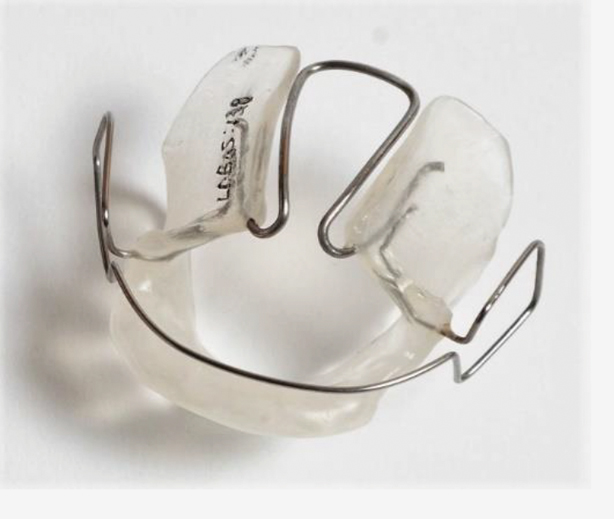Functional appliances
Functional appliances are mostly used to treat patients whose upper front teeth severely project in front of the lower teeth (known as a class I malocclusion) but can also be used when the lower teeth are over the upper teeth (class III malocclusion).They work to change the position of the jaws rather than just moving the teeth.
In the mid 19th century dentists began to think about the effect of facial muscles on bones and how this may be used to change the position of the jaws. In 1879 the American dentist Norman Kingsley designed the first functional appliance for patients whose mandible was too far back. A vulcanite plate sat on the palate and guided the mandible forward when the patient closed their mouth, a process Kingsley called ‘jumping the bite’.
The monobloc followed in 1902. Designed by Pierre Robin, the appliance was designed to treat children with glossoptosis syndrome. It was the first appliance to reposition the jaw and include an expansion screw to expand the arch.
In 1909 the Danish dentist Viggo Andresen removed his daughter’s fixed appliance, replacing it with a Hawley type retainer to which he added a lower arch shaped wire to move the mandible. It worked in correcting her class II malocclusion and so began Andresen’s interest in developing a functional appliance. The Andresen appliance was a passive appliance which sat in the mouth and was held in place by the work of the muscles around it. It was only worn at nighttime. Andresen later worked with Austrian pathologist Karl Häupl to develop the Norweigan system of functional jaw orthopaedics. Andresen’s appliance would go on to be modified by others, producing new types of appliance.

Andresen activator
Functional appliances gained popularity in Europe after World War II as the precious metals used for fixed appliances were difficult to obtain. Many designs were produced in the 1940s and 1950s including those by Bimler, Schwarz, Stockfish and Frankel.
Frankel’s function regulator was introduced in 1957. The appliance was a tissue born appliances, which meant it was position in the mouth with little or no contact with the teeth. There were five types of regulators to treat class I, class II and class III malocclusions. Despite the complexity involved in making the appliance it became very popular both in Europe and America.

Frankel’s function regulator III (on black model) with several examples of the function regular II
The Harvold Activator was developed by Egil Peter Harvold, a Norweigan dentist who later moved to America, in 1974. The activator is a modification of the Andresen appliance. The main differences being in the large opening in the appliance and in the relationship of the appliance to the teeth. The opening is designed to gain maximum effect from the movement of the muscles. Shelves covering the upper back teeth were designed to restrain their eruption while encouraging the lower back teeth to come through. This helped correct the relationship of the back teeth.

Harvold type appliance
Andresen’s Activator and its variants were passive appliances, relying on the action of the jaws. Increasingly popular in the later 20th century were active appliances such as Clark’s twin block technique, which is now the most commonly used functional appliance worldwide.
The twin block was developed by Scottish orthodontist William Clark in 1977 for the treatment of Class II malocclusions. The appliance consists of upper and lower bite blocks set on retainers. The blocks are set at a 70 degree angle which moves the lower jaw forward and downward when the mouth is closed. The appliance also uses the facial muscles to pull the upper teeth back. As the appliance is formed of two separate pieces, it could be worn full time and was more comfortable for the patient.